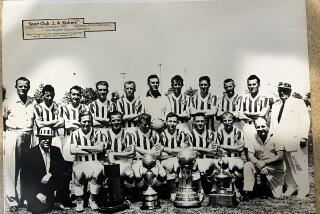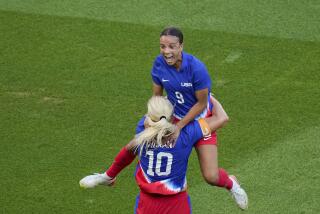Soccer’s All-Time UPSET
- Share via
The score flashed across the news wires: England 0, United States 1. Newspaper editors throughout Britain immediately assumed it was a typographical error, and the actual score was England 10, United States 1.
It’s only one of many myths, fables and legends that have grown from the famous 1950 World Cup match, some true, some false, and some that still--and probably will forever--remain a mystery.
Thursday’s 50th anniversary of the most famous upset in World Cup history again has its survivors talking about the match and the memories of the far more than 20,000 people estimated to have attended it in Belo Horizonte, Brazil.
Of all the stories about the match, none is more indicative of its mythical nature than Charlie Colombo’s late-game “rugby” tackle of Blackpool forward Stanley Mortensen.
In about the 80th minute, with England repeatedly pushing forward looking for the tying goal, Mortensen broke free of Colombo, the Americans’ center back, and was bearing down on U.S. goalkeeper Frank Borghi with no other defender between him and the goal.
“Then Charlie takes a headlong dive and hits him at the knees,” U.S. right back Harry Keough recalls. “Most (American) football guys don’t tackle that well.
“It’s something he should have been thrown out of the game for.”
Colombo grabbed Mortensen just outside the penalty area, but by the time they stopped tumbling, they were on top of the penalty spot. Italian referee Generoso Dattilo immediately whistled a foul and a free kick, but instead of ejecting Colombo, supposedly came up to him wagging his finger saying “Buono, Buono (Good, Good)!”
“Charlie claimed that to his dying day,” Keough said.
Adding to England’s frustration, on the ensuing free kick, Billy Mullen bounced a header downward that got behind Borghi. But Borghi reached back and palmed it away for Keough to clear.
England felt the ball had crossed the line. But Keough and Borghi claimed the keeper was off his line a few steps, so when Borghi reached back, it may have appeared the ball was over the line but in actuality never was.
Dattilo agreed with the Americans, and the result went down as the biggest shocker in the history of the World Cup.
“The longer the game went on, the more the crowd was on our side,” said Walter Bahr, the U.S. left halfback. “I’m sure they were expecting a slaughter. I thought a three- or four-goal loss would have been respectable.”
Borghi was expecting an even bigger loss.
“I thought when we did score a goal, the roof would cave in and they would score like crazy,” he said. “I was hoping to keep them to six or seven goals.”
Also on June 29, 1950, the West Indies won a test cricket match in England for the first time. As the Daily Herald wrote in its front-page headline: “England lose by 1 goal and 326 runs.”
Other headlines in England alerted its readers to the tragedy: “England Falls to U.S. Amateurs,” “Big Jolt For Our Soccer,” “Now U.S. beats us at Soccer.”
In the United States the result was met with little fanfare.
The New York Times ran an AP story on the fourth page of its sports section, behind baseball, Wimbledon, a duel athletics meet between the United States and Finland in Helsinki and a local women’s amateur golf tournament.
Only one American reporter watched the U.S. team at the World Cup, Denton McSkimming of the St. Louis Post-Dispatch. But he was there on holiday.
By the strictest definition, the Americans weren’t amateurs. Bahr was getting all of $25 a game for playing with the Philadelphia Nationals at the time.
But Bahr also was a school teacher; Joe Gaetjens a dishwasher; Keough a postman; Borghi drove a hearse; and Gino Pariani was working the line at Continental Can Company.
It was nothing compared to the English lineup, who had men like Alf Ramsey (England’s 1966 World Cup winning manager) and Tom Finney, both of whom would go on to be knighted for their soccer exploits.
England was so deep in talent, Stanley Matthews would not even play that day in Brazil, manager Walter Winterbottom instead relegating him to the grandstands. No substitutes were allowed in those days.
One of the biggest controversies was the fact that three players on the U.S. side weren’t even Americans: Gaetjens (Haiti), Joe Maca (Belgium) and Eddie McIlvenny (Scotland).
Eligibility rules were looser in those days and the U.S. Soccer Football Association allowed players who merely had declared their intention to become citizens. Later in 1950, FIFA would absolve the USSFA of any wrongdoing. Maca was the only one of the three that later became a citizen.
What cost the English that day, according to press reports and surviving players, was the plague of all teams at some time: poor finishing. Shots high, shots wide, and shots off the bar.
And even the one goal by Gaetjens in the 38th minute isn’t immune from controversy.
“The right wing (Bahr) came down, moved inside and took more of a shot than a center,” recalls England fullback Laurie Hughes. “And the ball struck (Gaetjens) on the side of the head and ended up in the top corner of the net.
“I consider that a fluke.”
Bahr admits to taking a shot, not a cross.
“There’s no controversy that I took a shot,” Bahr says. “The controversy is, was it an accident or did Joe purposely get to the ball. My memory is that he’s in the penalty area, the ball is coming toward him and he went after the ball.
“Whether he dove over, through or around somebody, he dove at the ball, and he got a piece of it. He deflected it, redirected it, I don’t know. He didn’t get the ball completely.”
It was enough to get it past a wrong-leaning Bert Williams, who is seen looking over his shoulder at the ball in one famous photograph said to be of the goal. Problem is, on close examination the photo also shows the ball on the outside of the back of the net.
Only 10 players survive from that day, five on each side, according to Colin Jose, the official historian of the U.S. Soccer Hall of Fame in Oneonta, New York.
Keough, Pariani and Borghi, all of whom still live in the St. Louis area, Bahr and John Souza are still around from the American team. For England, Williams, Hughes, Finney, Roy Bentley and John Aston are still alive. Only they can accurately recall what happened that day.
One thing Borghi remembers is being carried off by the locals.
“They carried me to the clubhouse,” Borghi says. “They picked up Gaetjens, they picked up John Souza and carried him off.
“People came at us and I didn’t know if they were mad at me or what.”
England players, for the most part, conceded they were beaten fairly on that day, although some groused about various things.
“The pitch wasn’t very good and the dressing rooms were bad,” halfback Billy Wright told the London Daily Mail in 1993. “But we lost, history was made and they will never let us forget it.”
LINEUPS
ENGLAND: Bert Williams; Alf Ramsey, John Aston, Laurie Hughes; Billy Wright, Jimmy Dickinson, Tom Finney, Wilf Mannion, Roy Bentley; Stanley Mortensen, Jimmy Mullen.
UNITED STATEs: Frank Borghi; Harry Keough, Charlie Colombo, Joe Maca; Eddie McIlvenny, Walter Bahr, Frank Wallace, Gino Pariani, John Souza, Eddie Souza; Joe Gaetjens.
REFEREE: Generoso Dattilo, Italy.
More to Read
Go beyond the scoreboard
Get the latest on L.A.'s teams in the daily Sports Report newsletter.
You may occasionally receive promotional content from the Los Angeles Times.







